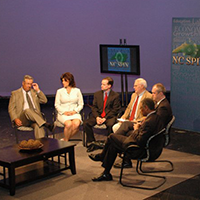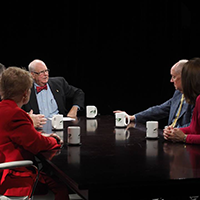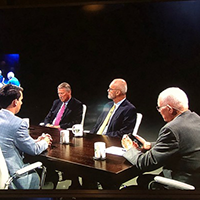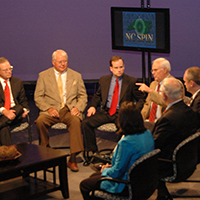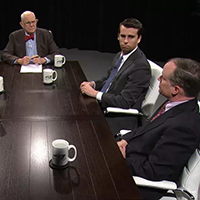How American conservatism came to be
Published July 3, 2025
By John Hood
I’m a conservative without a conversion story. Plenty of others have such a tale — they read a certain book, had a certain teacher, or somehow became disenchanted with their previous, left-leaning views.
If the conversion happened as adults, after first being politically active as a progressive, socialist, or communist, they were called neoconservatives. One of the most prominent, Irving Kristol, famously defined a neoconservative as “a liberal who has been mugged by reality” and a neoliberal as “a liberal who got mugged by reality but has not pressed charges.”
I only got mugged once, while working as a magazine reporter in Washington, and I was already a conservative. It was an attempted mugging, actually, because I happened to be carrying a synthesizer in a heavy case, it proved to be a handy weapon to swing, and the would-be mugger was stoned out of his mind.
But Kristol wasn’t really talking about crime as a political issue, of course, although the rise of criminality and social disorder during the 1960s, 1970s, and 1980s was a factor that propelled some Americans into the conservative movement. What bound the disparate elements of that movement together was the existence of critically important and inescapable realities — such as what the free-market economist Thomas Sowell later described as the “constrained vision” of human nature, as distinguishable from the “unconstrained vision” of would-be social engineers.
Modern American conservatism — lately we’ve been calling ourselves Freedom Conservatives — draws insights from what has long been called traditionalism and what usedto be called liberalism.
Traditionalists believe there are fundamental truths and virtues, either revealed by God or confirmed by millennia of human history, that ought to guide human action. Liberals (in the classical sense) don’t necessarily disagree with that premise, actually. But in politics, they elevate the principle of freedom to the top of the list — the right of individuals to make decisions for themselves above the power of the state to take their property and control their lives.
Traditionalists value freedom, as well, but observe that individuals aren’t born as human atoms who later, voluntarily, form human molecules. We are born into families and communities, and thus into a thick and complex web of social obligations. Many traditionalists, then, define freedom in communitarian terms, as “ordered liberty.” Classical liberals emphasize the right of the individual to make decisions, even if the results dismay their neighbors or injure themselves.
When cultural critics, libertarians, and anti-communists forged the modern conservative movement in America during the 20th century, they were reacting to the threatening rise of populism, progressivism, and socialism. It was a case of longtime rivals, traditionalists and classical liberals, forming first an alliance of mutual need and then, through fits and starts, forging a more systematic integration of their ideas.
The result wasn’t a catechism. It was and remains messy and incomplete. There are differences in definitions and emphasis. But the various strands of Freedom Conservatism have enough in common to work together — and what they have in common, for the most part, is a belief that governmental power should be minimized so that freedom can be maximized.
Why? Because it is in the nature of humans to thrive, in the long run, when they are free to make their own decisions, rather than being compelled to comply with some central plan. The empirical evidence for this proposition is massive and constantly growing.
For example, a peer-reviewed study by North Dakota State University economist Jeremy Jackson employed the Frasier Institute’s Economic Freedom of North America Index and a set of survey data on life satisfaction. All other things being equal, states with lower taxes, smaller budgets, and fewer regulations had a higher share of happy residents than did those with expansive, expensive governments.
My fellow Freedom Conservatives in North Carolina and beyond fight for liberty not as an abstraction but as a practical tool for promoting opportunity, progress, happiness, and virtue. And we welcome converts to the cause.
John Hood is a John Locke Foundation board member. His books Mountain Folk, Forest Folk, and Water Folk combine epic fantasy and American history.


